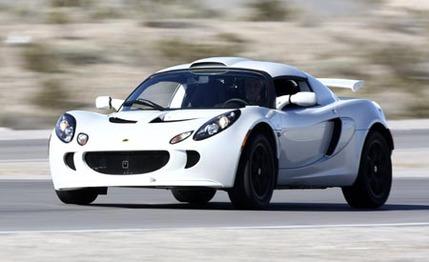
 First Drive Review
First Drive Review
Granted, we often get a bit technical here at Car and Driver, a nuance due in no small part to having an editor-in-chief who has an engineering degree from MIT and expects everyone to keep up with him during luncheon conversations, or at least nod enthusiastically.
But here's the simplest, least painful lesson in automotive engineering you'll ever find.
Today's topic: "Power-to-weight ratio."
Today's subject: The 2008 Lotus Exige S 240, introduced at the Los Angeles auto show.
According to Lotus, the 240 accelerates from 0 to 60 mph in 4.0 seconds and from 0 to 100 mph in 9.9 seconds, claims bolstered by our own informal stopwatch sessions. It does this with a Toyota powertrain—a 240-hp, 1.8-liter four-cylinder engine and a six-speed manual transmission.
The Mercedes-Benz S63 AMG, according to our own testing, accelerates from 0 to 60 mph in 4.5 seconds and from 0 to 100 mph in 10.8 seconds. It does this with a 518-hp, 6.2-liter V-8 with a seven-speed automatic transmission.
So the Mercedes, with well more than double the horsepower of the Lotus, is slower. How is this possible? The scales tell the story: The Mercedes weighs a portly 4910 pounds. The light-on-its-feet Lotus weighs a claimed 2100 pounds. The Mercedes has more than twice the horsepower but carries more than twice the weight. This, of course, points up an added benefit for the Lotus: an EPA-rated 23 mpg in the city compared with 11 mpg for the Mercedes.
The Back Story: Keep It Light
Light weight and utter simplicity have been the birthright of Lotus since the first one was built in 1948 by racing driver Colin Chapman. A very light car with a small engine could outrun a very heavy car with a large engine, Chapman reasoned, a thesis he proved on the racetrack over and over. Lotus became an enormous force in motorsports, entering Formula 1 in 1958 and winning the championship in 1963 and 1965 with Jim Clark, who died in 1968 while piloting, yes, a Lotus. That year, Graham Hill won the F1 championship for Lotus, and Jochen Rindt did the same in 1970, followed by Emerson Fittipaldi in 1972 and Mario Andretti in 1978. Future three-time champion Ayrton Senna won his first Formula 1 race with Lotus in 1985.
Chapman died of a heart attack in 1982, in the midst of a nasty controversy over his role in developing the star-crossed De Lorean sports car. Lotus designed much of the vehicle, and Chapman was facing an investigation regarding money laundering along with company founder and former General Motors executive John De Lorean. After Chapman's death, Lotus struggled, both in motorsports and its side businesses of building cars and selling engineering expertise.
General Motors bought Lotus in 1986 but had no idea what to do with it. Lotus was selling its Ferrari-like Esprit in the United States in small numbers, but GM figured the name was worth something. So it had Lotus build the Elan, an odd little sports car, powered by a four-cylinder Isuzu engine, that Lotus tried to sell in the United States for $40,000. Unfortunately, the 1991 Elan looked a lot like the 1991 Mercury Capri, which cost about $27,000 less.
In 1993, GM sold Lotus to a company in Luxembourg owned by an Italian businessman, who also owned what was left of Bugatti. The company went bankrupt. In 1996, Lotus was sold to Perusahaan Otomobil Nasional Sdn. Bhd., otherwise known as Proton, the state-owned Malaysian car company.
Lotus purists were appalled, but after one major setback—the company's Malaysian chairman was killed in a helicopter crash in 1997—Proton, which builds some good small cars for the European market, turned out to be a decent curator of the Lotus legend. Without Proton's money, Lotus might well have folded its tents for good, but the company finally found its footing in the U.S. with the introduction of the 2005 Elise.